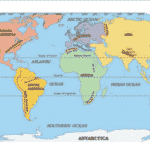Archaeologists have found evidence of early farmers and herders at a number of places. The beginning of domestication started about 12,000 years ago. The following table shows where evidence of grain and bones of domesticated animals have been found.


TOWARDS A SETTLED LIFE
- Archaeologists have also found traces of huts or houses at some sites.
- In Burzahom, people built pit houses, which were dug into the ground, with steps leading into them. These may have provided shelter in cold weather.
- Cooking hearths have been found both inside and outside the huts. This suggests that, depending on the weather, people could cook food either indoors or outdoors.
- Stone tools have been found from many sites as well. Many of these are different from the earlier Palaeolithic tools and that is why they are called Neolithic.
- These include tools that were polished to give a fine cutting edge and mortars and pestles used for grinding grain and other plant produce.
- Tools of the Palaeolithic types continued to be made and used.
- Some tools were also made of bone.
- Many types of earthen pots have also been found. These were sometimes decorated and were used for storing things.
- People began using pots for cooking food.
- Grains like rice, wheat and lentils now became an important part of the diet.
- They began weaving cloth using materials like cotton which could now be grown.
A CLOSER LOOK AT MEHRGARH
- The beginning of settlement at Mehrgarh started about 8,000 years ago.
- Mehrgarh is located in a fertile plain, near the Bolan Pass, which is one of the most important routes into Iran.
- It was probably one of the places where people learnt to grow barley and wheat, and rear sheep and goats for the first time in this area.
- Evidence of many kinds of animal bones from the earliest levels have been found during the excavation of this site. These included bones of wild animals such as the deer and pig.
- In later levels, they found more bones of sheep and goat, and in still later levels, cattle bones are most common, suggesting that this was the animal that was generally kept by the people.
- Remains of square and rectangular houses have been found. Each house had four or more compartments, some of which may have been used for storage.
- Several burial sites have been found. In one instance, the dead person was buried with goats, probably meant to serve as food in the next world.
Q: When archaeologists are digging at an excavation site, how do they know which level is earlier and which is later?
A: Suppose people first start living on flat land. Over the years, the surface will gradually rise, because people discard waste material, and generally stay and rebuild houses in the same place. After hundreds of years, this leads to the formation of a mound. So, when this mound is dug up, what is found from the upper layers of the mound is generally from a later time than what is found from the lower layers of the mound, which are older. These upper and lower layers are often referred to as levels.
A CLOSER LOOK AT DAOJALI HADING
- It is a site on the hills near the Brahmaputra Valley.
- Here stone tools, including mortars and pestles, have been found. These indicate that people were probably growing grain and preparing food from it.
- Other finds include jadeite, a stone that may have been brought from China.
- Tools made of fossil wood (ancient wood that has hardened into stone) and pottery have also been found.
Read More: Class 6 Ch 2 History-On the Trail of the Earliest People










